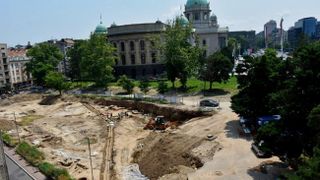Roman aqueduct and 'luxurious' burials unearthed during construction of underground parking garage in Serbia
The finds in Belgrade date from the period when the city was a regional center of the Roman Empire.

Archaeologists have unearthed several Roman tombs and the remains of an aqueduct in the center of Belgrade, the Serbian capital.
The finds date to the period when the city was a settlement, known as Singidunum, within the Roman Empire.
"So far, we have discovered 14 Roman tombs from the third and fourth centuries," Milorad Ignjatović, an archaeologist at the Belgrade City Museum, told the Serbian website Sve o arheologiji ("All about archaeology").

The site has different styles of Roman tombs. "Two of the tombs have rectangular bases with arched vaults walled with bricks, while two others are made from bricks stacked in the form of a coffin," he said in comments translated from Serbian. "We have also discovered four stone sarcophagi, which were considered the most luxurious way to be buried in Roman times."
The excavations in the center of Belgrade have been going on since March, ahead of the construction of an underground parking garage.
The finds weren't a complete surprise; Roman tombs were unearthed nearby 40 years ago.
The latest excavations first turned up ruins of the bombings by Allied forces at the end of World War II, when the Nazi Germans had invaded and occupied what was then Yugoslavia, as well as the remains of an Ottoman Turkish settlement at the site from the 17th and 18th centuries.
But the Roman-era tombs started appearing in the excavations just a few weeks ago. "All our expectations came true," Ignjatović said.





Roman Singidunum
According to the city government of Belgrade, Singidunum was established at the site of an earlier Celtic town in the first century after the Roman defeat of hostile tribes in the area.
It then became one of the main settlements of the Roman province of Moesia, a frontier region south of the Danube River. Soldiers from at least two Roman legions were garrisoned there to protect it and the nearby lands from "barbarian" invasions by Dacians, Dardanians, Scordisci and other hostile tribes.
The emperor Hadrian, who ruled from A.D. 117 to 138, granted Singidunum city status and made its inhabitants Roman citizens, and the emperor Jovian, who ruled from 363 to 364, was born there in 331.


Singidunum then became a center for Roman Christianity in the region, and for a time it was part of the Eastern Roman Empire (also known as the Byzantine Empire). But it fell in 441 to an invasion of the Huns, who burned it to the ground and enslaved its inhabitants.
Related: Where is Attila the Hun's tomb?
While archaeologists at the site suspected they would find tombs, they were not expecting the remains of a Roman aqueduct.
The team has unearthed about 200 feet (60 meters) of lead pipe from the aqueduct. Ignjatović thinks it was built during the second century as an extension of an earlier aqueduct that had supplied water to a Roman fort nearby.
Most of the Roman-era tombs in Belgrade were looted in later times, but some artifacts remain, including parts of a gold necklace and a unique glass hairpin. They will now go on display in the Belgrade City Museum, Ignjatović said.
Live Science newsletter
Stay up to date on the latest science news by signing up for our Essentials newsletter.
Tom Metcalfe is a freelance journalist and regular Live Science contributor who is based in London in the United Kingdom. Tom writes mainly about science, space, archaeology, the Earth and the oceans. He has also written for the BBC, NBC News, National Geographic, Scientific American, Air & Space, and many others.
Most Popular

By Tom Metcalfe


By Keith Cooper

By Sascha Pare